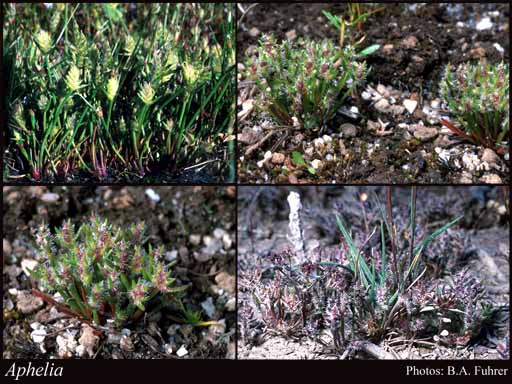- Reference
- Prodr.Fl.Nov.Holland. 251 (1810)
- Name Status
- Current

Scientific Description
Family Centrolepidaceae.
Habit and leaf form. Grass-like herbs. Annual. Leaves basal. Plants with a basal concentration of leaves. Leaves alternate; spiral; sessile; sheathing. Leaf sheaths with free margins. Leaves simple. Leaf blades entire; linear (to subulate); 1–3 -nerved; parallel-veined. Leaves eligulate; with a persistent basal meristem, and basipetal development. Vegetative anatomy. Plants with silica bodies, or without silica bodies. Leaf anatomy. Leaf blade epidermis without differentiation into ‘long’ and ‘short’ cells. Guard-cells ‘grass type’. Stem anatomy. Secondary thickening absent.
Reproductive type, pollination. Fertile flowers functionally male and functionally female. Unisexual flowers present. Plants monoecious. The unisexual flowers aggregated in different parts of the same inflorescence (the male florets generally enclosed in the primary bracts and separated from the female florets, the females forming higher up on the spike), or not conspicuously in separate aggregates (in A. cyperoides and A. gracilis). Male flowers without pistillodes. Floral nectaries absent (nectaries absent). Anemophilous.
Inflorescence and flower features. Flowers aggregated in ‘inflorescences’; in ‘spikelets’. The terminal inflorescence unit cymose. Inflorescences scape erect, terete, consisting of a single internode; terminal; a spike, with the primary axis bearing several distichous bracts; the bracts each enclosing a sessile part-inflorescence that may be reduced to a single male or female floret; not pseudanthial (the florets never fused). Flowers bracteate (primary bracts 1–2, differentiated from the distal bracts, usually with apices similar to laminae of leaves; distal bracts 4–16, all similar, successively reduced in size, imbricate at anthesis, each ultimately shed with individual fruits); bracteolate (the male and sometimes female flowers with thin subtending ‘bractlets’); small. Perianth absent. Fertile stamens present, or absent (female flowers). Androecium 1 (constituting the male flower, as here interpreted). Androecium exclusively of fertile stamens. Stamens 1. Filaments glabrous; capillary. Anthers ellipsoid to ovoid; dorsifixed; versatile; dehiscing via longitudinal slits; unilocular; bisporangiate. Fertile gynoecium present, or absent (male flowers). Gynoecium 1 carpelled (constituting the female flower). The pistil 1 celled. Gynoecium monomerous; of one carpel; superior. Carpel apically stigmatic (the persistent, filiform style with unbranched, stigmatic papillae all along the adaxial side); 1 ovuled. Placentation apical. Ovary stipitate. Ovules pendulous; non-arillate; orthotropous.
Fruit and seed features. Fruit non-fleshy. The fruiting carpel tardily dehiscent (by an adaxial slit); a follicle (tiny). Gynoecia of adjoining flowers combining to form a multiple fruit. Dispersal unit the seed. Fruit 1 seeded. Seeds fusiform; copiously endospermic. Endosperm not oily (starchy). Perisperm absent. Seeds with starch. Embryo rudimentary at the time of seed release (minute, obconical). Testa smooth. Seedling. Germination epigeal (seed remnant visible on apex of the cotyledon (which appears as the basal leaf)). Hypocotyl internode absent. Mesocotyl absent. Seedling collar not conspicuous. Cotyledon hyperphyll elongated; assimilatory; more or less circular in t.s. Coleoptile absent. Seedling cataphylls absent. First leaf centric. Primary root ephemeral.
Geography, cytology, number of species. Native of Australia. Endemic to Australia. Australian states and territories: Western Australia, South Australia, Victoria, Australian Capital Territory, and Tasmania. South-West Botanical Province.
Taxonomic Literature
- Wheeler, Judy; Marchant, Neville; Lewington, Margaret; Graham, Lorraine 2002. Flora of the south west, Bunbury, Augusta, Denmark. Volume 1, introduction, keys, ferns to monocotyledons. Australian Biological Resources Study.. Canberra..
- Cooke, D. A.; Adelaide Botanic Gardens 1995. A taxonomic revision of Aphelia (Centrolepidaceae).